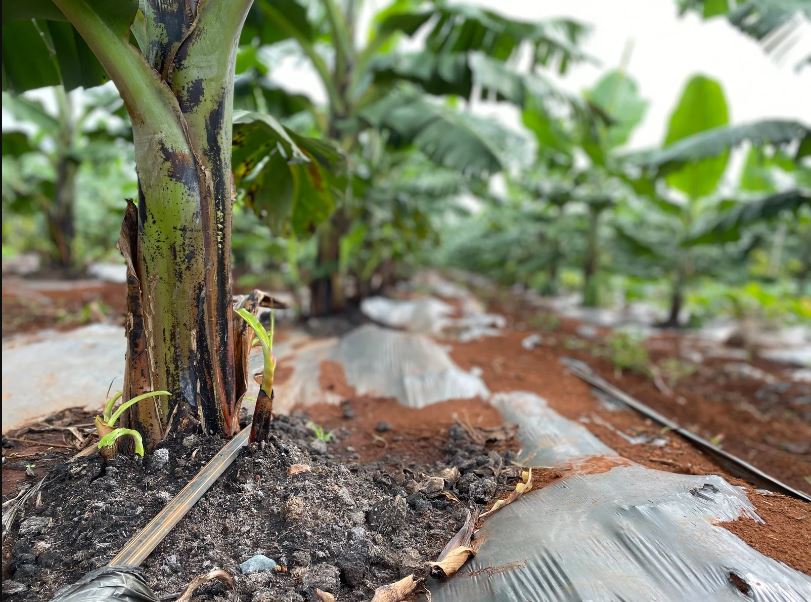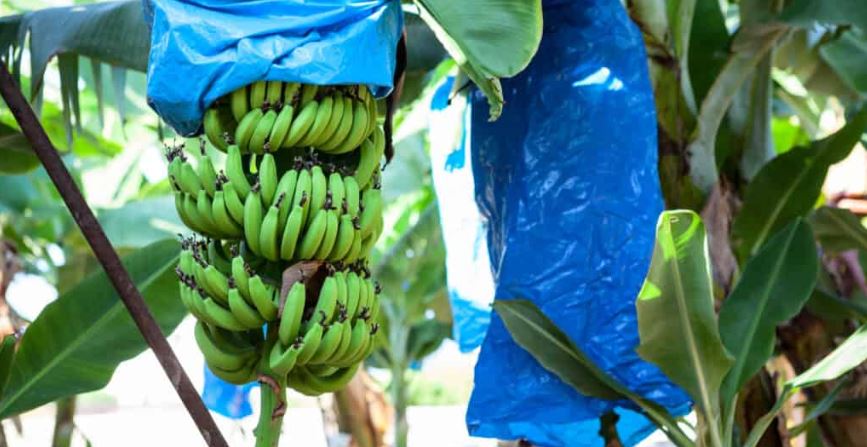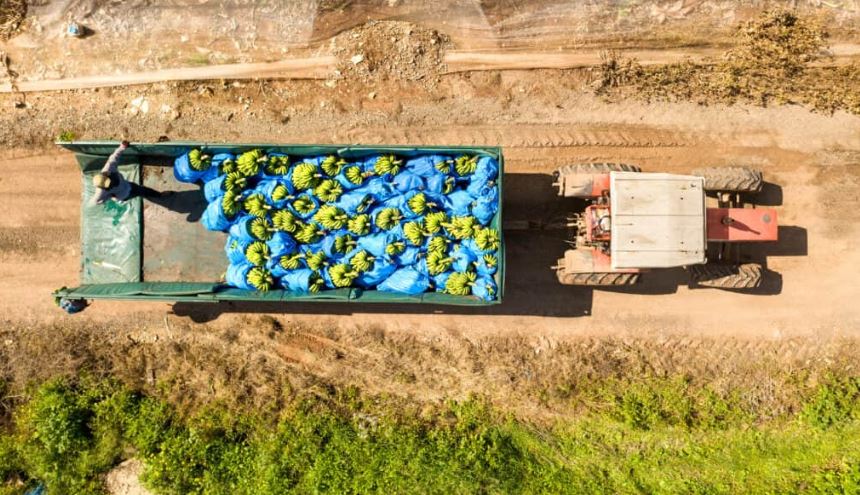Desuckering of a banana plant means cutting off unwanted shoots from the stems of the mother banana plant. This will increase the banana plant size.
Proper watering of the banana plant is very important to ensure proper growth and production. Read more below, especially about drip irrigation. When customers pick out bananas in the store, they prefer the ones with the least amount of blemishes, bruises, or cuts on the outside of the peel. These bananas have probably been covered with banana bags. The covering of bananas yields better fruit quality and increases its market value, specifically because of a blemish-free appearance.
Desuckering
- Use a knife to cut off the stems of the suckers which have grown to about the size of a foot.
- When planting on a slope, always leave the suckers which are on the uphill side.
- In the southern hemisphere cut off all suckers which are on the north western side of the banana plant. This is the side where the bunch hangs. 4. After five months from planting, select only one vigorous sucker to carry the next bunch. Cut the remaining suckers. Continue removing unwanted suckers as they appear. Do not pour diesel over the stems of the suckers.
NB: It is important to keep not more than 2 222 plants per hectare. Therefore, after harvesting only one sucker should be allowed to grow.
Removing leaves
Remove lower hanging, yellow leaves from the plant. The old leaves can spread diseases and they can scratch and damage the fruit on the bunch. Use a knife to cut off the old leaves from the banana plant-do not pull them. After removing them you can place them on the ground-they mulch the surface and increase nutrient content in the soil.

Drip irrigation provides in the water needs of banana trees without wasting water. (Photo: Netafim)
Irrigation
For top quality banana production and record yields, precision irrigation is needed. This will allow you to produce top quality bananas in the demanded quantities, and all at the right time. From getting the perfect finger size to extending the productive life of each plantation to the fullest, precision irrigation allows you to maximize your profits. Dry spells can pose a major risk to banana productivity, even if you grow in a rainy area. With precision irrigation, you can lower climate related risks and reduce the unpredictable factors common to banana growing, thereby increasing your production stability.
If you give your bananas exactly what they need you can save on your resources. Drip irrigation is the perfect system that provides the most efficient delivery of water and nutrients to the roots of your bananas, letting them grow to their full potential. With precision irrigation and modern agricultural practices, you can increase your productivity per hectare while enjoying the ability to deliver constant shipments of highquality produce to your markets
How to water banana plants:
- Irrigate newly-planted tissue culture banana plants every day for 2 weeks (15 minutes per irrigation) to protect leaves from heat stress.
- In the absence of rain, irrigation water should be applied on a “little and often” basis to banana plants.
- For heavy loamy soil apply 20 mm of water every 3 days in summer and every 8 days in winter.
Example: Nozzle delivery = 3 mm per hour For every irrigation, run the system for 20 hours divided by 3 hours. This equals 6 hours and 40 minutes (20/3 = 6 hours, 40 min). Netafim has a perfect and reliable drip irrigation system for your banana production. Get more information here: https://www.netafim.com/en/products-and-solutions/product-offering/drip-irrigation-products/
Bagging bananas on the trees
Covering the banana bunches with bags will protect them against insects and wind. The types of bags used include transparent, blue polyethylene, half blue and half silver plastic, all-season bunch covers, and PP non-woven skirting bags. Some bags, mainly used by commercial growers, are saturated with insecticides to protect banana crops. These bunch covers or banana bags protect bananas and other fruits against pathogens, damage from wind, birds, and sun, scarring, and damage during harvesting. Additionally, banana bags can protect fruits from freezing temperatures and reduce stress.

Bagging bananas on trees provides better quality fruit without blemishes. (Photo: Tree Journey)
Different types of bags have different functions
Protection against the sun:
Transparent bag covers are mainly used to block UV rays from the sun. These bags allow for better light and temperature to penetrate the bananas
and increase their growth. In certain conditions, where sunscald is an issue (basically sunburn on bananas), transparent bags are not used. Blue polyethylene bags are commonly used by large-scale, or commercial banana farms. The blue polyethylene blocks UV rays but still allows heat to penetrate, promoting optimal growth. These bags also prevent infestations from insects, and provide protection against birds and other environmental factors.
Maintain proper temperature of the bananas:
Half blue and half silver plastic bags have a dual cooling and heating feature. Facing the blue side towards the north (the sun) and the silver side towards the tree increases the temperature within the bag during the winter months. The opposite is true during the summer and warmer months. Facing the silver side towards the north (the sun) during the summer months decreases the temperature within the bag. This dual feature helps keep a constant temperature in the bag to improve fruit growth. An all-season bunch cover is a bag used to protect against harsh growing conditions. It was developed in Australia and ensures even heating, lighting, and development of bananas. They also have more UV protection than other banana bags.
Controls ripening of bananas:
Next is the PP (polypropylene) nonwoven skirting bag. These bags are made of a fabric that protects without sacrificing water permeability. This type is supposed to help control the ripening of bananas and allow airflow and moisture circulation. It is also said to block insect and pathogen infestations completely.
This article is published with acknowledgement to the ARC-Institute for the use of their manuals. For more information on banana production, visit the ARC’s website at www.arc.agric.za.
Additional sources:
DeAngelis, Z. 2022. Why They Put Bags On Banana Trees And How It Works. https://treejourney.com/why-theyput-bags-on-banana-trees-andhow-it-works/
Netafim. 2022.Products and solutions. https://www.netafim.com/en/products-and-solutions/productoffering/drip-irrigation-products/









